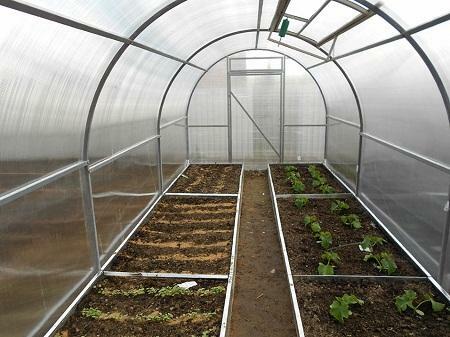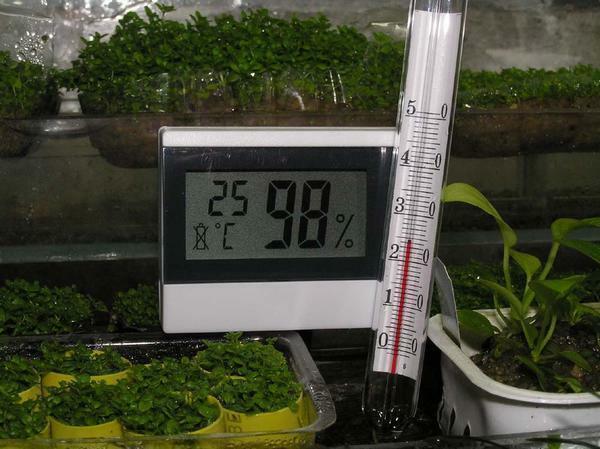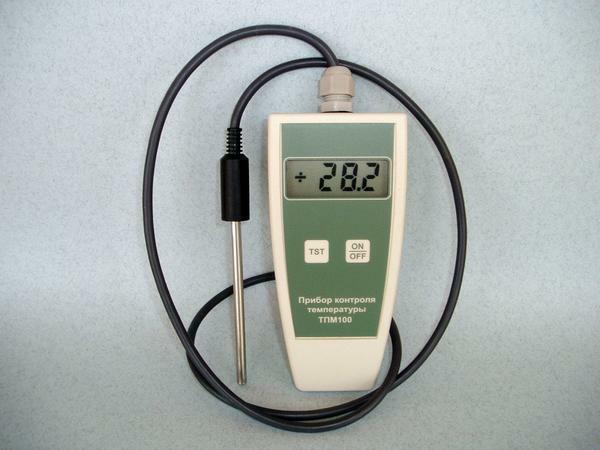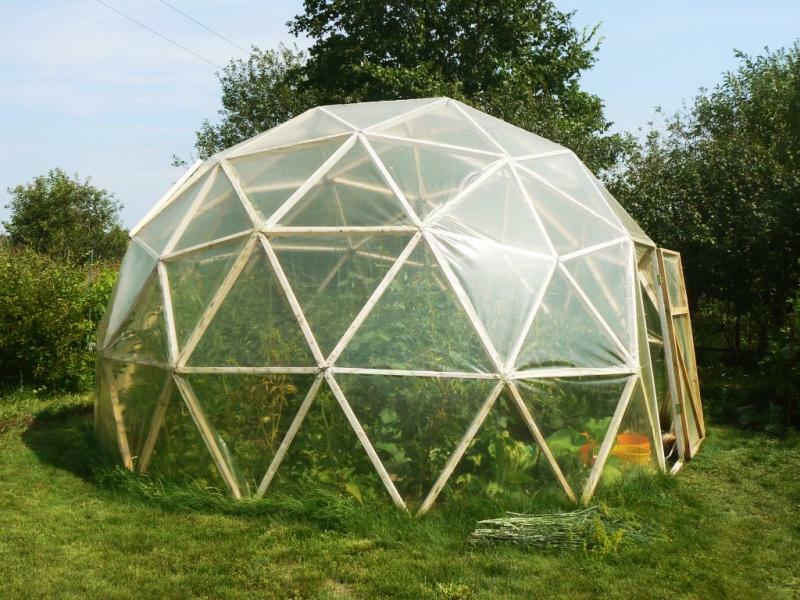 From the temperature and humidity in the greenhouse depends on the quality of the future harvest microclimate in glass greenhouses and hothouses of polycarbonate depends on the level of room humidity and soil temperature and air exchange. In order to grow a good harvest, you need to constantly monitor these indicators, creating a comfortable environment for plants.
From the temperature and humidity in the greenhouse depends on the quality of the future harvest microclimate in glass greenhouses and hothouses of polycarbonate depends on the level of room humidity and soil temperature and air exchange. In order to grow a good harvest, you need to constantly monitor these indicators, creating a comfortable environment for plants.
-
- Why is the soil moisture in the greenhouse
- How the control of the temperature and humidity in the greenhouse
- What should be the temperature and the optimum humidity in the greenhouse
- As can maintain the humidity in the greenhouse
- optimum temperature andhumidity in the greenhouse( video)
Why is soil moisture in the greenhouse
during the entire period of growth of the crop in the greenhouse humidity is important. It creates a certain microclimate, which is necessary for plant growth. Lack of moisture in the soil, as well as its search, can adversely affect the yield.
Lack of water in the soil can lead to drying of the crop, and moisture increase - to its decay.
 If the soil is too dry, it can lead to death of the plant
If the soil is too dry, it can lead to death of the plant
Soil moisture must be maintained with respect to the surrounding conditions. The greatest need of plants in the moisture falls on the period of active growth of seeds or planting seedlings. Soil moisture should be 90-95%.During the ripening period, the moisture content should not exceed the level of 80% moisture, and when fruit ripens - 85%.In autumn, after harvesting and in winter, the permissible level of moisture in the earth is 65%.
When growing crops, you also need to consider which plants are in the greenhouse. For example, cucumbers need regular moderate watering of soil, and tomatoes - a rarer, but abundant watering. The humidity level for them is also different, therefore it is not recommended to grow their water greenhouse.
For vegetables in the greenhouse is also important the water temperature, which will moisten the soil. Do not use cold water from a well or directly from a tap. The optimum temperature is 24 degrees.
How is the temperature and humidity control in greenhouse
For greenhouses is very important to solve the control of temperature and humidity. If you want your plants not to die and bring the desired result, it is necessary to monitor these indicators. In addition, they are interrelated - the control of one indicator is not complete without the other. If the temperature drops, humidity rises, and vice versa, raising the temperature leads to air drying.
It is very difficult to monitor every hour for the indicators. At night, the temperature drops, and this is all inextricably linked with the change in the indicators in the greenhouse. Temperature control comes first. To do this, you can install a temperature controller with a temperature sensor and connect it to the heating element and cooling system. Thus, the thermostat will maintain a constant temperature.
Sensor DVT-03.NE1 - a special device for monitoring and regulating the humidity and temperature in the room.
 You can buy a humidity control device in the greenhouse in the grocery store
You can buy a humidity control device in the greenhouse in the grocery store
Humidity adjustment is also important. Measuring the humidity can be measured by the hygrometer of the air. If you can not purchase this device, you can do it yourself. This will require 2 mercury thermometers and a psychrometric table, which can be downloaded on the Internet.
How to make the device:
- On the board, fix two thermometers vertically parallel to each other;
- Under one of the thermometers to place a container of purified water;
- The mercury tip of the thermometer is wrapped with a cotton cloth and gently tied with a thread;
- The edges of the fabric should be lowered into a container with water for 5 mm;
- Readings taken every 10 minutes to determine the humidity level in the greenhouse;
- Compare the readings of a dry and wet thermometer, calculate their difference;
- At the intersection of the difference and the indicator of the dry thermometer in the table, determine the relative humidity in the greenhouse.
Based on the values obtained, you can determine what should be done - increase or decrease the humidity in the greenhouse. To increase the humidity - to establish a fogging system. Automating the reduction of humidity is also possible by installing water dryers.
What should be the temperature and optimum humidity in the greenhouse
For plants growing in a greenhouse, it is very important to create the right conditions. Humidity, like soils, affects the yield of plants. Humidity of air in the greenhouse directly depends on soil moisture and temperature in the greenhouse. During the period of seed growth and flowering, plants require a higher level of humidity. The result of a low level of humidity during the flowering period can be plant diseases, low yields or complete absence of fruits.
 The recommended temperature for growing a plant is indicated on the reverse side of the seed package
The recommended temperature for growing a plant is indicated on the reverse side of the seed package
Also at low humidity, there is a risk of mites that could damage the crop.
Ideal level of humidity of air 50-60%, soil - 65-85%( depending on plants).In this case, the temperature in the room should not exceed 30 degrees during the daytime and not fall below 8 at night. At night, the land should be as dry as possible, as the temperature goes down, and the high humidity in the greenhouse can cause plant disease. The increased temperature sterilizes the pollen on the inflorescences of plants, which can cause an empty ovary - therefore, when the temperature rises, it is very important to keep the moisture in the ground, not to let it completely evaporate.
If abnormalities occur, it is necessary to correct them urgently, otherwise the plants may suffer. At a temperature inside the greenhouse of +40 degrees, plants can die, lowering the heat will help airing or raising the humidity.
How it is possible to maintain humidity in the greenhouse
In large industrial greenhouses, expensive humidity control systems are installed that regulate this level on their own. However, in small greenhouses such installations are not always advisable to install, so it is necessary to monitor the humidity and temperature independently. Too dry and too important air can adversely affect the yield, so you need to constantly monitor the humidity.
To maintain optimum moisture in the greenhouse, you need to install an artificial moisturizing system. Increase the humidity can be due to watering the paths from the hose, and spraying water - this system is mounted at the top of the greenhouse and sprays small droplets of water through the hotbed. Due to higher humidity in the air, the temperature in the greenhouse will decrease.
At night, the temperature in the greenhouse is reduced and, accordingly, the humidity of the air and soil should be minimal.
 To maintain optimum humidity it is recommended to regularly ventilate the
To maintain optimum humidity it is recommended to regularly ventilate the
If a large amount of condensation accumulates inside the greenhouse, there is a risk of developing harmful bacteria that can damage plants.
Tips for controlling condensate:
- Sprinkle beds with lutrasil or mulch - this will slow the evaporation of moisture from the soil.
- To lower the humidity level, it is enough to open windows occasionally and to ventilate the greenhouse, thereby letting in fresh air. Airing is permitted only when the temperature outside the greenhouse is 10 degrees below the inside of the greenhouse. In most cases, this is an early morning, when the street temperature is + 15-16 degrees.
- Cover the ground with a thin transparent film that will lower the rate of evaporation of water from the ground. You can also use dry straw, but removing it will be more difficult than film.
The ventilation system is also important, it can support not only the level of humidity, but also the temperature level and the overall microclimate in the greenhouse. Ventilation improves air exchange and does not allow the appearance of drafts that are harmful to plants.
Optimum temperature and humidity in the greenhouse( video)
In order to grow a good harvest, it is very important to monitor the temperature and moisture inside the greenhouse. Do not forget that each culture requires a certain level of humidity and it is not recommended to combine some types of plants in the greenhouse.


